True Stories
Page 2 of 42
 Elan Impression 45
Elan Impression 45
“It saved us because the electric autopilot refused to work 3 days before arrival in Martinique. Thanks to HV we were able to keep moving with a crew of 2.”
From: Carsten Spräner
Sent: February 21, 2024
To: John Curry
Subject: Carsten Spräner | ELAN Impression 45
Want to share our Hydrovane installation which is quite kind of rare. Maybe it helps other boat owners with large platforms at the stern to keep the platform useable AND having the HV not to much off center.
[EDITOR’S NOTE: For several reasons, we do not typically recommend through-hull installations. Most drop-down transoms are better accommodated with an offset installation. However, for some very limited boats it is the best option and can work well – as in this case]
We sailed with this through hull installation over the Atlantic east to west and it worked perfect. It saved us because the electric autopilot refused to work 3 days before arrival in Martinique. Thanks to HV we were able to keep moving with a crew of 2.
THANK YOU! The HV is a great tool!
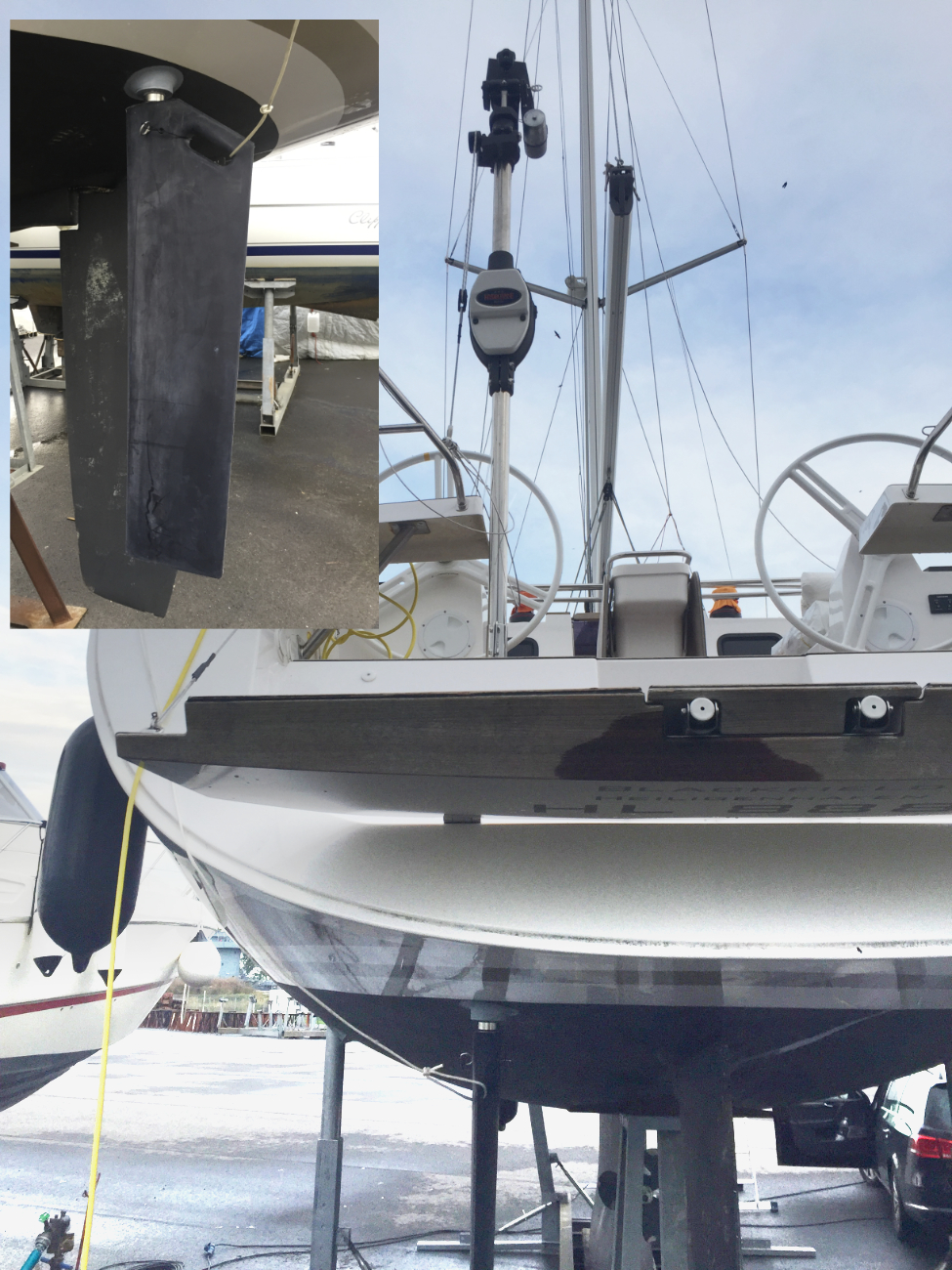
 Seastream 43
Seastream 43
“The Hydrovane steered us all the way back to NZ [from the UK]. What an amazing kit! Love her!”
From: Helen Shrewsbury
Sent: January 14, 2024
To: Richard Minielly
Subject: Hydrovane crack
Happy new year!
We are now back in NZ after a fabulous sailing journey from UK with the help of our trusted Hydrovane.
I’ve just noticed a couple of cracks in one of the brackets. Picture attached. What should we do to remedy this please?
Thank you.
Helen
From: Richard Minielly
Sent: January 17, 2024
To: Helen Shrewsbury
Subject: Hydrovane crack
Hi Helen,
Nice to hear from you. Congratulations on the long passage back to NZ! Were you able to use the Hydrovane most of the way?
To start with, I would give the Hydrovane a good clean to figure out exactly what is a serious crack and what is just some surface disturbance. Start with mild soap and water, then let that dry and spray the entire unit down with WD40. Use WD40 and a mild abrasive pad (for instance a white ‘light duty’ Scotch-Brite pad instead of the green ‘scouring’ pad) to then remove any white spots left on the unit.
After cleaning, it’s a good practice to use a corrosion inhibitor such as T9, CorrosionX, or wax-based products on the castings to help protect them.
To deal with the cracks, it depends a bit on the severity. At the moment, it looks like the damage is fairly mild. If you clean out all the white build up, you should be able to put some epoxy in to stop the crack spreading. Fill the crack with epoxy and put a spray of grey metal pain on top for protection, and the casting should be good for another few thousand miles. [Editor’s note: Lanocote or TefGel can also be used where the anodized coating has been worn away over a small area]
If the cracks are deeper than they appear or start spreading, we’ll need to replace that specific casting. Unfortunately, there is no reliable method to repair the cast aluminium. Some customers have had good success with brazing, a popular fix in machine shops in Southeast Asia, but we wouldn’t be able to guarantee the part.
Happy to chat further.
Best Regards,
Richard
From: Helen Shrewsbury
Sent: January 17, 2024
To: Richard Minielly
Subject: Re: Hydrovane crack
Legend. Thank you Richard. We’ll give your suggestions a go.
The Hydrovane steered us all the way back to NZ. What an amazing kit! Love her!
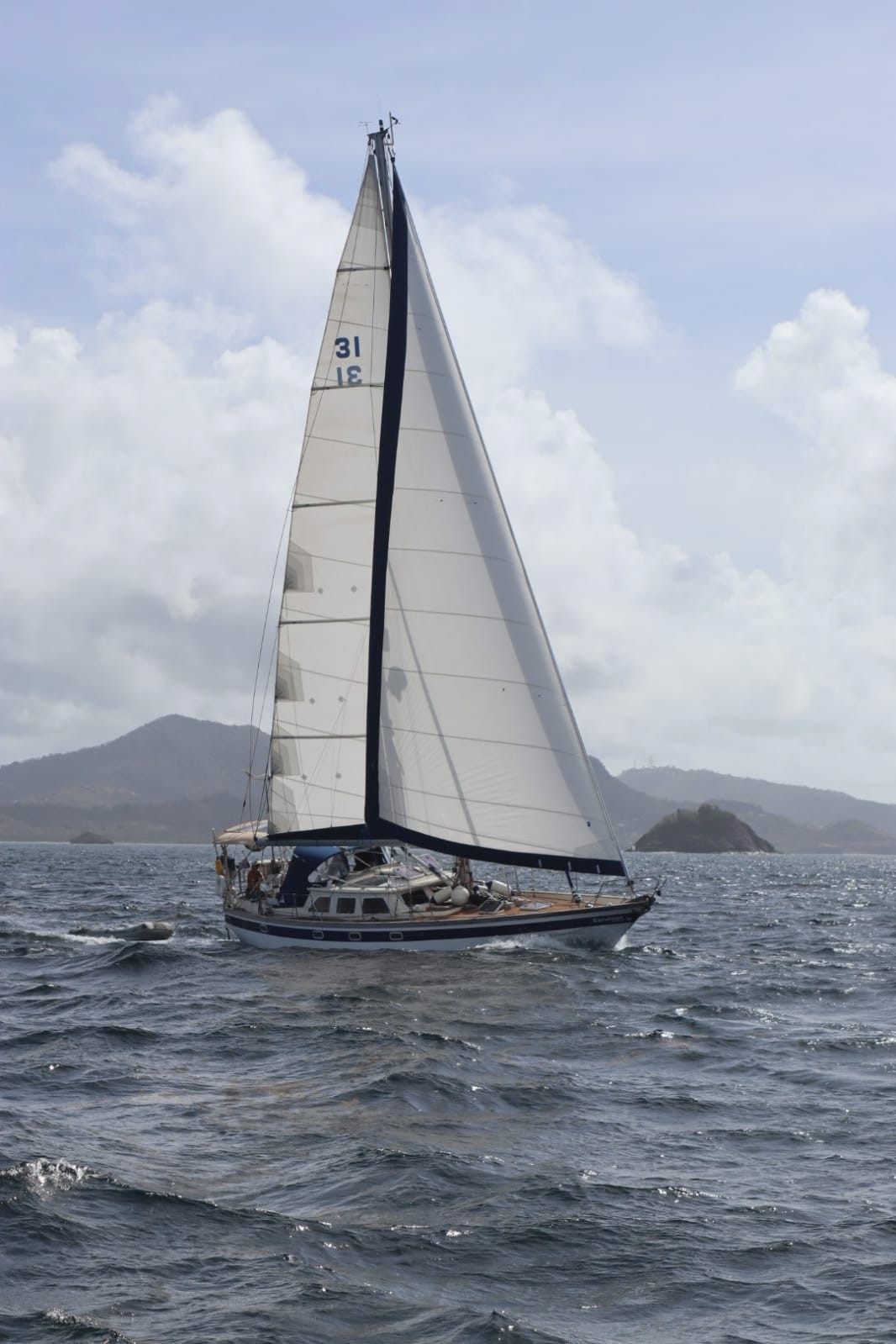
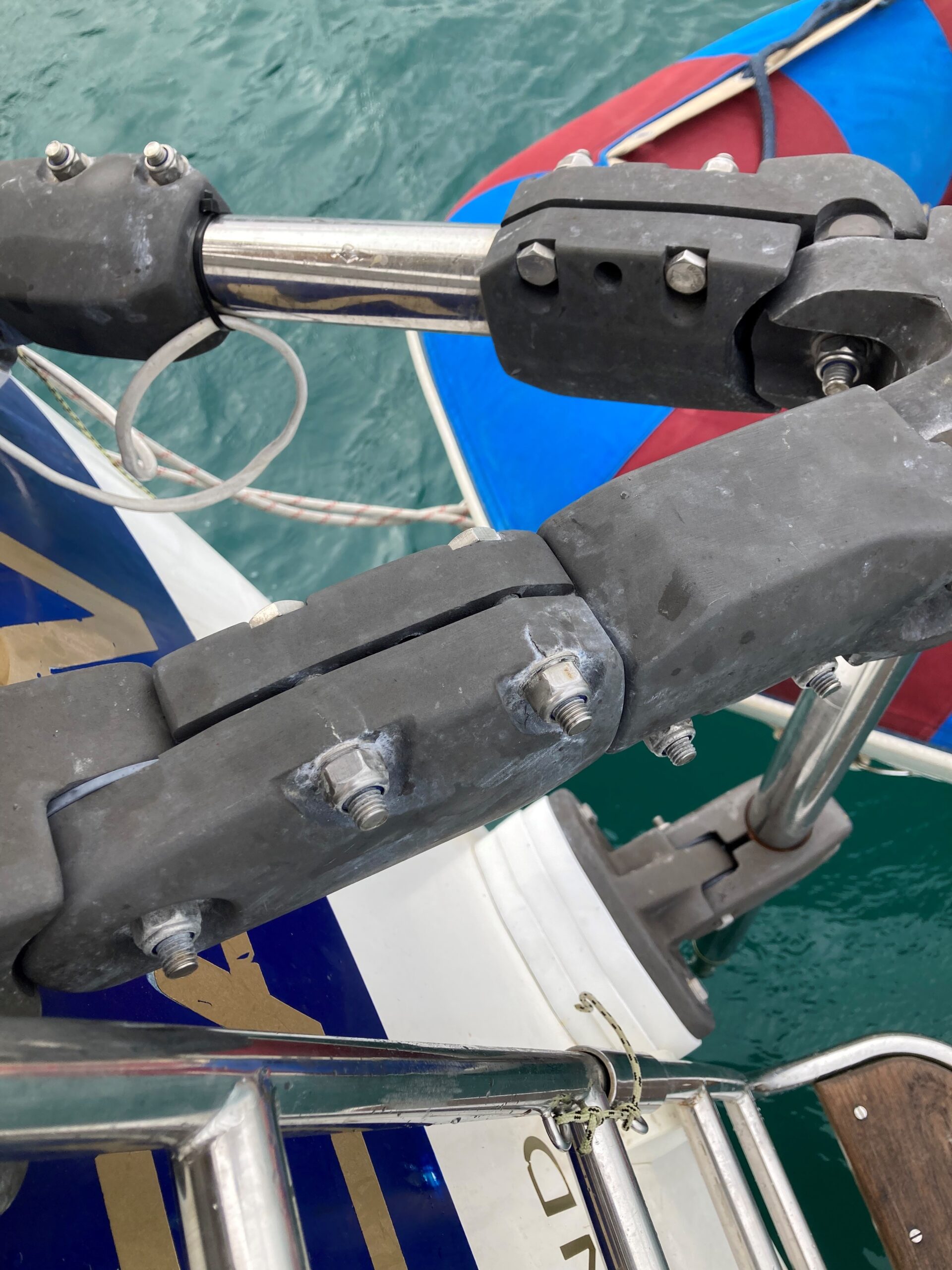
 Moody 33 Mk I
Moody 33 Mk I
“My advice to anyone crossing the pond or Pacific or any other big expanse of deep water: have a Hydrovane fitted.”
From: Trevor & Rebecca Martin
Sent: January 17, 2024
To: Sarah Curry
Subject: Re: hydrovane
Hi
I have the Moody33 Mk1 which you had in your gallery for a while.
Anyway I have to say, the Hydrovane was the best bit of kit I purchased for the boat.
It took a bit of getting used to, especially in marinas and harbours, but out on the sea, oceans it performed like a none sleeping crew member with the accuracy of a pocket computer, 24/7 it steered, for hours on end, with just the odd tweek now and then.
We crossed the Atlantic in 2023, 2100nm, the Hydrovane steered in heavy and light trade winds with minimal adjustments.
My advice to anyone crossing the pond or Pacific or any other big expanse of deep water, have a Hydrovane fitted.
Regards
Trevor Martin
Dignity too of Edinburgh
Hull number 14
Moody 33 Mk1
From: Sarah Curry
Sent: January 17, 2024
To: Trevor & Rebecca Martin
Subject: Re: hydrovane
Hi Trevor,
Thank you for reaching out. It is so wonderful to receive such emails and hear what you’ve been up to. We still have the photos of Dignity Too of Edinburgh on our website; it’s a great installation.
We’re thrilled that Hydrovane steered you across the Atlantic. The Hydrovane sure loves those trade winds and you’re right about it being the sleepless crew member!
I hope you’re enjoying sailing somewhere wonderful.
Would you mind if we post your comments on our website?
Warm regards from a snowy Vancouver,
Sarah
From: Trevor & Rebecca Martin
Sent: January 17, 2024
To: Sarah Curry
Subject: Re: hydrovane
Hi Sarah
Sorry forgot to say, we are in Cartagena Colombia.
The Hydrovane took us from UK to Spain, Portugal, Canaries, Mindelo, Martinique, Caribbean islands, ABC’s, to Colombia.
She didn’t fail us or let us down once.
True and steady, minimally tweaking.
Cheers
Trev
Contact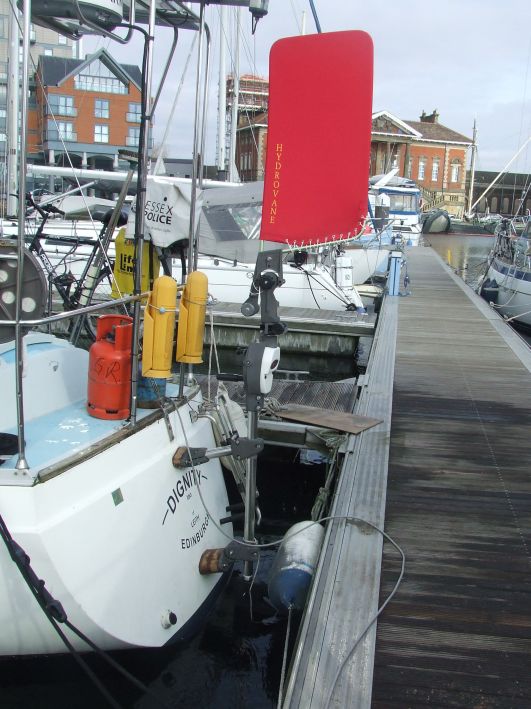
 Moody 47
Moody 47
“We have also used the Hydrovane for 2 x 100Nm legs already here in the Caribbean and so far am very impressed and wish I had purchased one a long time ago.”
From: Lee Adams
Sent: December 17, 2023
To: Will Curry
Subject: Re: Used hydrovane possibility here in Grenada
Afternoon,
Just to let you know I installed the Hydrovane on our 2001 Moody 47 following the detailed YOUTUBE videos you produced and the excellent installation manual. Please see some installation pics attached for your reference.
We have also used the Hydrovane for 2 x 100Nm legs already here in the Caribbean and so far am very impressed and wish I had purchased one a long time ago. See video attached of it being used in 20 to 25kt winds.
Finally, met a fellow Hydrovane user here that gave me a top tip: Before you engage the Hydrovane, balance the sails and then set the electronic autopilot as that can give a good indication of where to lock the wheel off. Then lock the wheel and engage the Hydrovane.
Regards
Lee Adams
Contact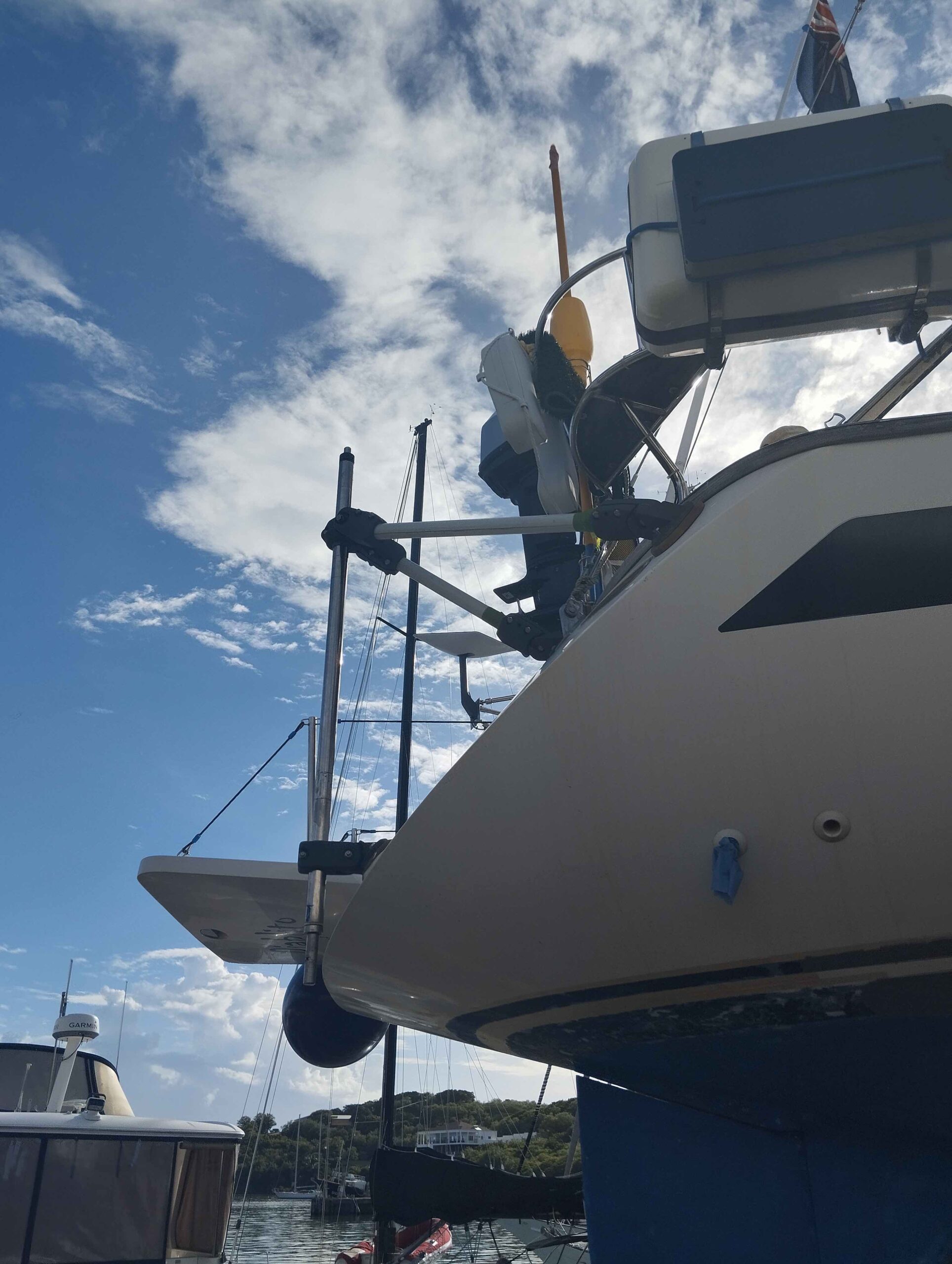
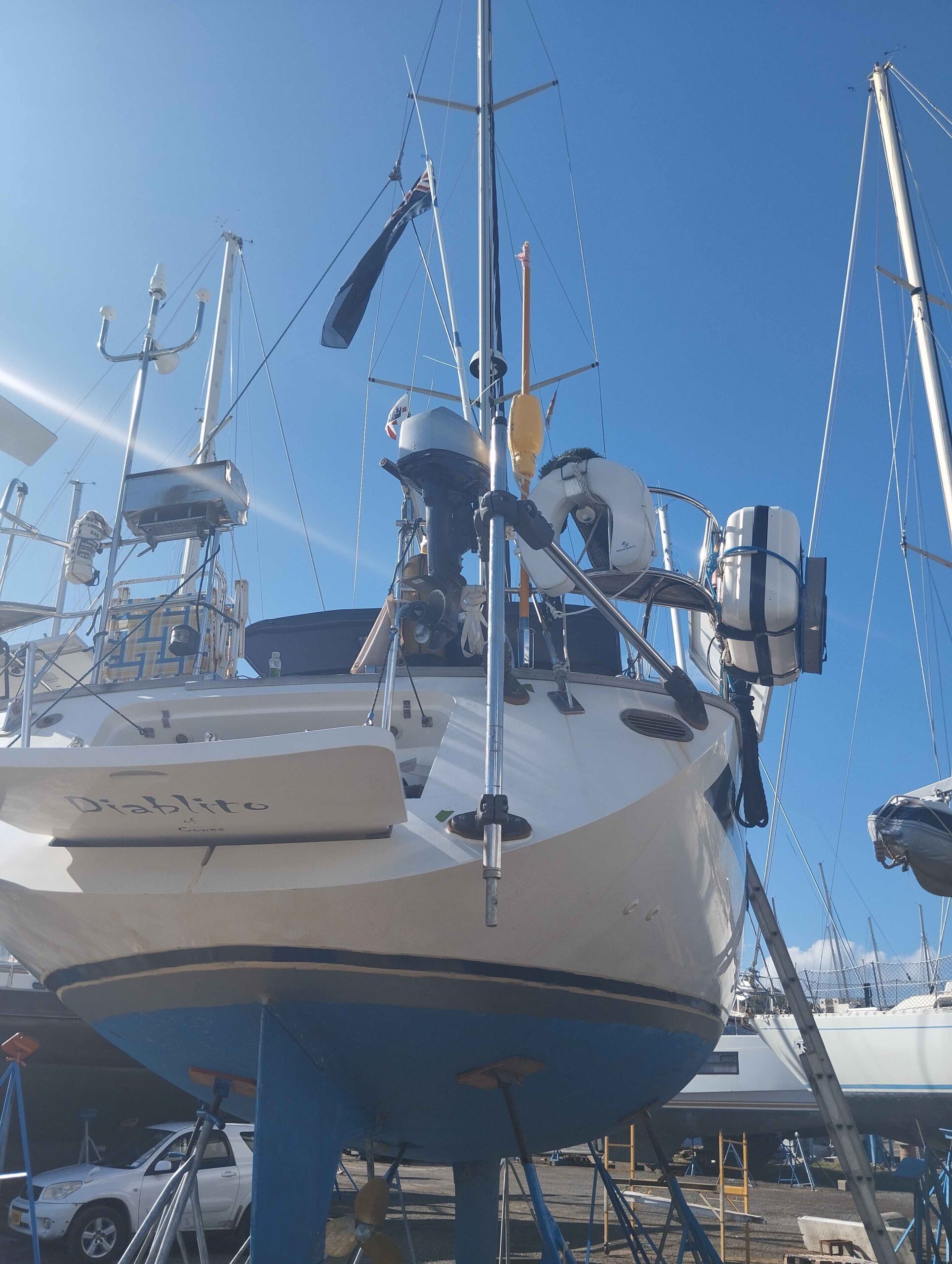
 Moody 40
Moody 40
“Goes great.”
From: Bernie Trim
Sent: December 16, 2023
To: Will Curry
Subject: Awesome
Here’s a few pics of the unit.
Goes great.
Install was ok.
The instructions were great
Needed to make a second hardwood wedge for top bracket and there was a decent epoxy pad made for inside .
Can i change the angle of the course adjuster so the line runs more direct ?
Looks like a quick adjust but I thought I would ask first , just loosen the 13mm nut and twist ?
I’ve used it in Moreton Bay with 15-20kn
Great
Around 6 kn wind and it struggles.
Departing on the 20th for South Pacific 12 month adventure
Regards
Bernie
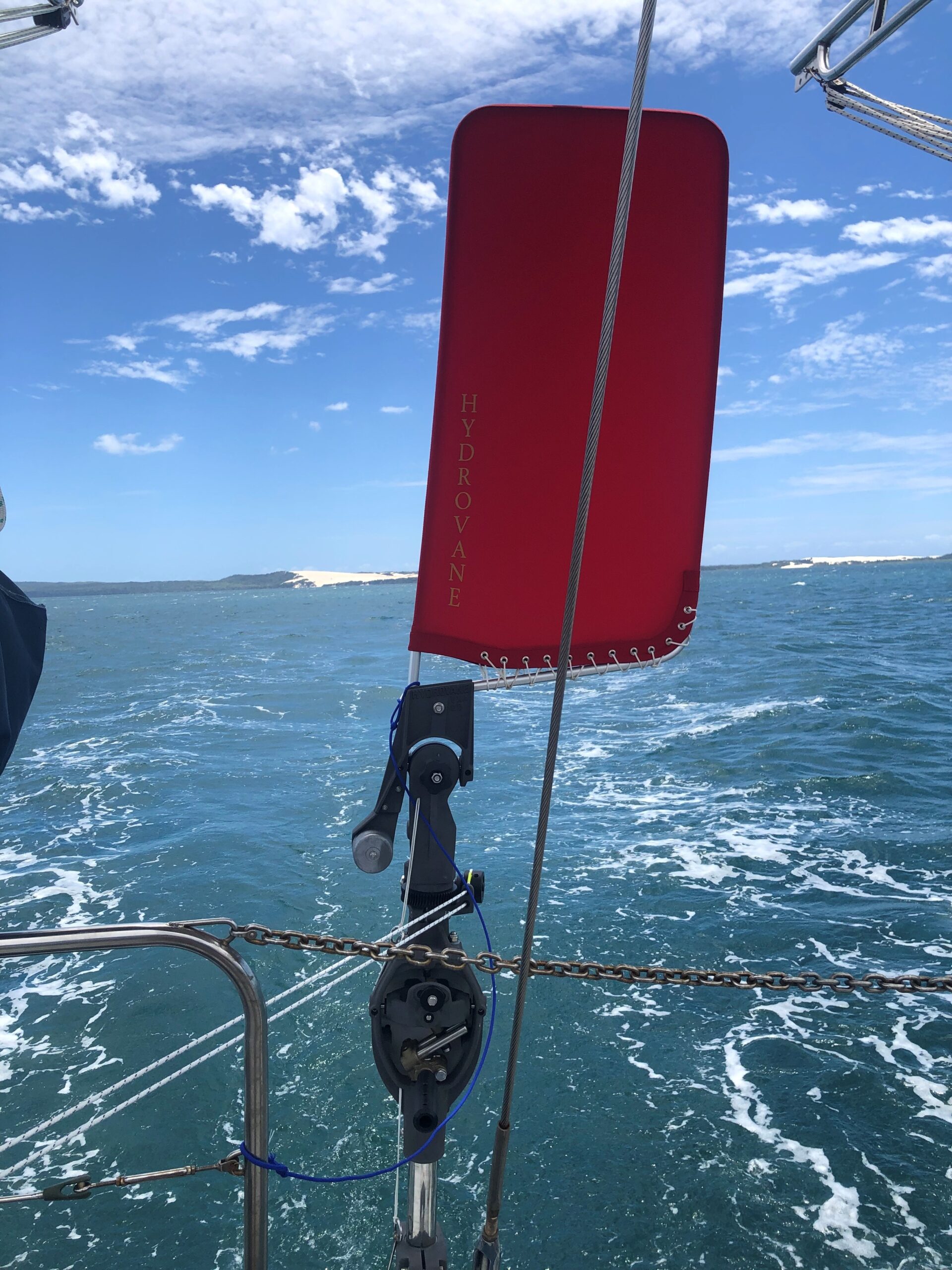
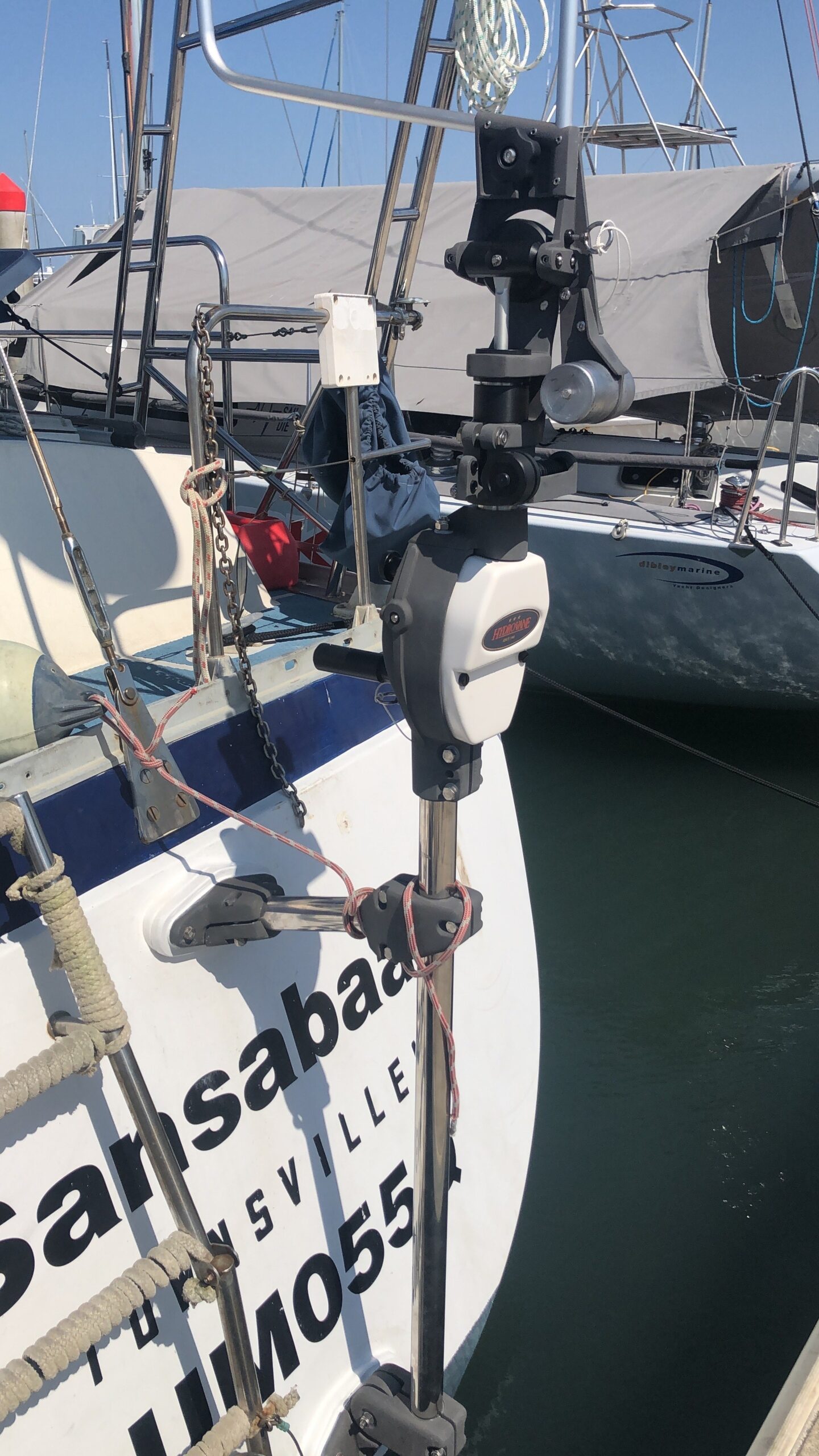
 Hunter 356
Hunter 356
“The Vane has been an excellent companion in all weather conditions.”
From: Damien Tremolet
Sent: December 8, 2023
To: Richard Minielly
Subject: Question on keyway pin
Hi Richard and all,
I hope you and the team are well.
We made our way safely and pleasantly to West Indies, currently in St Vincent. The Vane has been an excellent companion in all weather conditions. Sometimes challenging to tune but we learnt and improved over time !
We found recently an issue with the key way pin (on the shaft meant to ease the insertion of the rudder) photo attached. There are signs of corrosion and now it does not fit correctly (too loose in the hole). We found this out when removing temporarily the rudder.
What is your advice ?
Kind regards,
Damien
From: Richard Minielly
Sent: December 8, 2023
To: Damien Tremolet
Subject: Question on keyway pin
Hi Damien,
Great to hear from you, and I’m happy to hear that your Hydrovane was a valuable companion across the Atlantic! There is definitely a learning curve to sailing with a windvane, but once dialled in the process is generally quite rewarding. Do you mind if we post your email to our True Stories page? No worries if you prefer to remain private.
That’s very interesting that the pin fell out. We haven’t seen that before, although some corrosion in that area is quite normal. The pins are originally glued in place, and it’s likely that yours had an issue with the bond that allowed it to come out and for water to penetrate in and speed up the corrosion process. It can be glued back in place with a strong epoxy, which should also fill any gaps from the lost material.
If you’d like, we’re happy to provide a new keyway pin. However, as it would be the same spec and subject to high shipping costs to St. Vincent, I would recommend re-using the existing pin with a thick epoxy adhesive instead. If you have any technical questions on the process, I’m happy to help.
Best Regards,
Richard Minielly
Contact Hallberg Rassy 42E Ketch - Video
Hallberg Rassy 42E Ketch - Video
“Too rough for the hammock?”
“Even with conditions like this the hydrovane is completely reliable and does it’s job. No more handsteering necessary. So what to do with our time? To rough for the hammock?”
 John Kretschmer Sailing - Kaufman 47 - Video
John Kretschmer Sailing - Kaufman 47 - Video
“1000 miles sailing a serious ocean in the Southern Atlantic! I experienced my first Storm Force 10 with +4m waves and lightning, which was every bit as real and terrifying as John’s books!”
Repost @ejcrosse @johnkretschmersailing
“As billed, truly epic “heavy weather” training passage from Rio de Janeiro to Punta Del Est in Uruguay with #johnkretschmersailing on the beautiful Quetzal.
1000 miles sailing a serious ocean in the Southern Atlantic! I experienced my first Storm Force 10 with +4m waves and lightning, which was every bit as real and terrifying as John’s books!
We’ve just arrived safely in Punta Del Est and will be heading to Argentina in two days time.
What was my biggest takeaway from this experience…? I need a bigger boat!” ⛵️
On our way from Lagos down to Las Palmas we had awesome weather, Sharon took the helm and played on the waves, we then tried the Hydrovane self steering which as you’ll hear from the video I was quite impressed with……. 👍🙂
 Kirsten Neuschager - WINNER Golden Globe Race 2022
Kirsten Neuschager - WINNER Golden Globe Race 2022
“[The Hydrovane] saw Kirsten and Minnehaha all the way through the Golden Globe Race (non stop, solo, around the world) and over the finish line!”
From @kirstenggr
Thinking back on the sailing, and missing it! Thanks to @hydrovane for having serviced Minnehaha’s hydrovane, which did about 45 000 nm before having any major overhaul – possibly more than any hydrovane has ever done before without a significant service. It saw Kirsten and Minnehaha all the way through the GGR and over the finish line! The unit is as good as new again, and it was smooth sailing all the way down to Madeira! Also, a big thanks to Eddie Arsenault, for having built such a solid mounting bracket for the hydrovane! Without Eddie, Minnehaha would just not be the strong boat that she is today!
Minnehaha – Cape George 36
 Callisto 385
Callisto 385
“The Hydrovane is like having a third crewmember onboard!”
@cutterbove_sailing_ Tony adjusting our Hydrovane and setting our course.
The Hydrovane is like having a third crewmember onboard! It’s an independent self-steering system, can be used as an emergency rudder (take note, anybody planning to pass through the Iberian orca territory!), and beats the autopilot hands down in many ways… it doesn’t use electricity, and it doesn’t freak out and kick you off in stronger winds or bigger seas.
We are very happy to have ours onboard.
 Van De Stadt 36 - Video
Van De Stadt 36 - Video
“Win No. 1: We put a Hydrovane on our boat before we left.”
From @sailingsolsticetide
Sailing to Mexico – great read here:
https://currents.bluewatercruising.org/articles/rookie-mistakes-and-the-things-we-did-right/
“Win No. 1: We put a Hydrovane on our boat before we left. This was possibly the best money we have ever spent on our boat. The unit is not inexpensive but it drove for us nearly the entire way down the west coast and on all our big crossings. If you are considering a self-steering vane – do it. We love our Hydrovane but of course there are many options – anything that lets you let go of the wheel (maybe get into a bit of shade) is a bonus – especially when it is not costing you precious power!!”
⛵️VAN DE STADT 36
📸 Hydrovane hard at work as the sun sets
 Hylas 46
Hylas 46
“Lucy – the Hydrovane (self-steering gear) – is a superstar!”
“Lucy – the Hydrovane (self-steering gear) – is a superstar! She steered almost all the way from Kinsale (Ireland) across the Bay of Biscay to A Coruna in Spain, and kept on course in light winds, strong winds, flat seas and very lumpy seas! We’re so pleased to have her on board!”
 Bavaria Vision 46 - VIDEO
Bavaria Vision 46 - VIDEO
“Bavaria Vision 46, Blur, close hauled on port tack with the Hydrovane on the ‘uphill’ side steering a perfectly straight course.”
“Bavaria Vision 46, Blur, close hauled on port tack with the Hydrovane on the ‘uphill’ side steering a perfectly straight course.
This was in 18kts of wind with one reef in the main and half a reef in the genoa.
You can see the angle of heel is not excessive and so there was plenty of the vane’s rudder in the water.
We had a speed through the water of between 6.7 and 7.1 kts.
This was on the far-right setting which moves the rudder least. In other words steers just like a good helmsman…. hence the straight track and good boat speed.
We found it pointed the boat up in the gusts just like a human would and came back on course as the gust eased.”
 Steel 30
Steel 30
“The Hydrovane performed wonderfully in conditions that my electronic pilot could not have controlled.”
“After a 120 mile cruise in 20 to 25 knot winds on the stern I couldn’t be more pleased with the pilot! The Hydrovane performed wonderfully in conditions that my electronic pilot could not have controlled. I installed the course correction system rope right next to the cabin entrance so I practically don’t even have to go out on deck to change course!”
⛵️ Steel 30, July 2023


